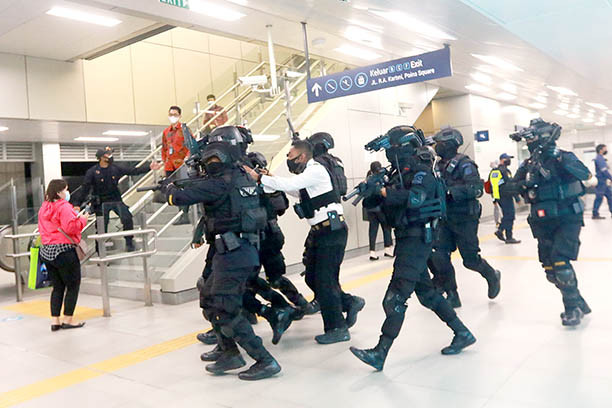The Eras of Fx Harsono
Memory: A piece used in the Burned Victim video performance from 1998
Change Size

Memory: A piece used in the Burned Victim video performance from 1998.
A charred body lies on a low table while an array of machine guns, pistols, a chainsaw, metal chains and needles of various sizes are placed on the next table ' a reminder of the country's violent history.
Items, the look like the appliances from a house of pain are parts of an art installation of artist FX Harsono, express the people's anger and frustration with the government-backed abuse of the New Order regime.
Titled 'The Life and The Chaos: Objects, Images and Words', the exhibition at the Erasmus Huis, Dutch Cultural Center, which runs until Oct. 30, does justice to the lifetime work of the country's seminal figure in the contemporary art world.
Curator Hendro Wiyanto put together the work and written records of the art works and the artist himself starting from 1974, allowing the public to get a glimpse into Harsono's progression over four decades.
'It is the obligation of the 2014 Prince Claus Award laureate to present his work in the exhibition,' said Hendro.
Harsono, 66, was nominated to receive the special Dutch award for his outstanding and inspiring achievements in the field of culture and development.
Although nearly all of the artworks on display are no longer in their original form, a timeline is printed on the wall with photographs of the works and detailed information on them attached to them.
The wall also has quotes from the artist taken from different interviews as well as neon letters that read: 'Bercita-cita besar tak lupa moral [Aim high, but don't forget morality],' his life's motto.
'The main concept of the exhibition is to create a discourse by allowing visitors to literally read the text and the subtext of the artworks.
'Each work connects to an event that marks the social and political development of the country,' said Hendro.
The timeline summarizes the work of Harsono and divides it into several chapters based on different eras of how he perceived his own work.

The first part of the timeline subtitled 'Harsono and The New Art Movement' shows a string of events during the New Order regime that triggered student demonstrations and the writing of petitions protesting the government's policy on elections, the Marriage Law and the construction of the Beautiful Indonesia Miniature Park (Taman Mini), among other issues.
Harsono and other artists also wrote a petition against the decision of the judges of the Indonesian Painting Exhibition in 1974, described as the Black December Manifesto.
They were known as the motivators behind the New Art Movement that introduced contemporary art that was socially committed.
As the movement disbanded due to internal conflict by 1980, Harsono entered the next chapter of the timeline in which he became an artist-activist, lending his voice to criticize the destruction of the environment as the cost of development, media gagging and a dam project in Madura.
He rejoiced at the fall of then president Soeharto's regime at the end of the era but at the same time captured the May 1998 riots that preceded the resignation of Soeharto in his 'Indochaos', a five-piece commemorative stamps parody.
At the start of the Reform Era chapter during which the new regime repealed regulations drafted by its predecessor to repress Chinese-Indonesians, Harsono began to appear in his work and extensively used Chinese culture and letters to reaffirm his identity as a Chinese-Indonesian.
His identity search went deeper as Harsono dug into the family's archives in Blitar, East Java and found a collection of photographs his father had taken in the 1950s of the mass grave of Chinese-Indonesians slaughtered in the early years of Independence.
His documentary video Proyek nDudah (Excavation project) marked the Historical Chronicle chapter of the timeline.
'Country of origin or roots are not important things in my life. In fact, it can be said there is no geographical or cultural site that can be called my country of origin or my cultural roots,' Harsono said in an interview in 2010.
'I have only the story of where I was born and raised. This historicity for me is more important than cultural roots.'
The timeline ends with a list of awards he has received, including the Joseph Balestier Award for the Freedom of Art in January.
'For Harsono, contemporary art is an attempt by an artist to create a counter opinion against forms of oppressive power, as well as an attempt to show partiality toward marginalized people whose voices are silenced,' explained Hendro.
'And this exhibition displays the artistic dimension of the socially committed art Harsono has always been looking for.'
Photo credit: JP/Tertiani ZB Simanjuntak









